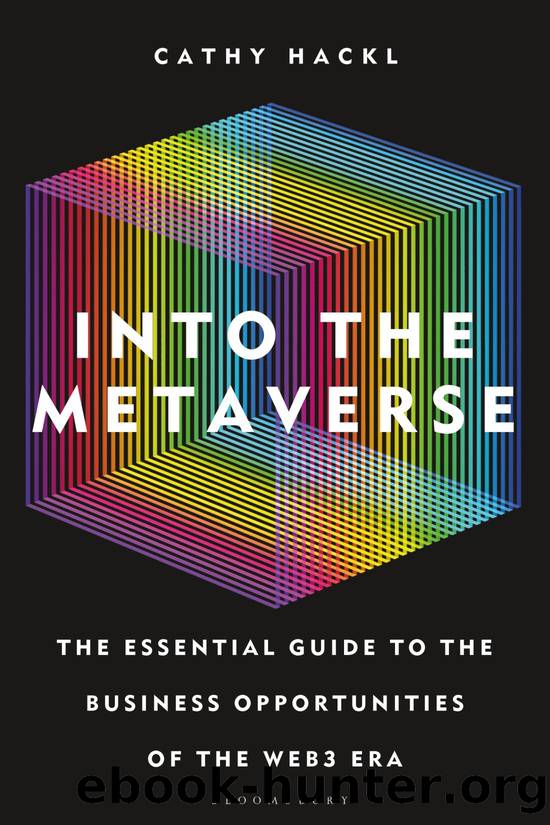Into the Metaverse by Cathy Hackl

Author:Cathy Hackl
Language: eng
Format: epub
ISBN: 9781399401791
Publisher: Bloomsbury Publishing
Published: 2022-09-13T00:00:00+00:00
A word to the wise
Thereâs huge potential to turn the concept of targeted ads on its head in the Metaverse. By creating more engaging experiences within the brands that consumers already want to engage with or want to learn more about, companies will be able to turn ads into experiences that attract these customers to their brands.
However, thereâs a darker side to targeted ads in the Metaverse. Targeted ads in the 2D web rely on data collected about personal users based on things like click rates, dwell time, the context of other sites that they have visited, and the information that those sites have gatheredâthatâs a lot of data. Throw in head-mounted displays and the data is even more in depth.
While we think about our own experiences within VR, we often do not realize that those experiences are invasive because the headset needs to know our physical environment to establish the bodyâs orientation in physical space. This requires external cameras that, as we look into a VR headset, are looking at our homes or offices. This is doubly true for AR, which also inherently incorporates computer recognition and machine learning to understand even more about our surroundings. While weâre not aware of companies misusing this technology, itâs important to be aware that they certainly could.
Further, the headsets arenât only reading our environment, theyâre also increasingly able to read us. More and more headsets can determine and record a wearerâs gaze within experiences. This technology enables things such as more realistic social interactions, more efficient displays, and more user-friendly controls. However, it can also be used to learn a great deal about how users are thinking and behaving within experiences. This can be paired with other advanced trackers, such as the face tracker available for VIVE. Other even more advanced headsets, like HPâs award-winning Reverb G2 Omnicept Edition, promise even more detailed information about the state of the user within VR, including highly personal details like their cognitive load.
To be fair, the Reverb is targeted toward research, medical, high-end enterprise, and training applicationsâthat kind of tech isnât found in just any headset. Information HP can gather has huge potential benefits within those fields. However, as VR advances, it is conceivable that more headsets in the future will have these kinds of capabilities. Together, these technologies can be applied toward what XR ethicists are calling âbiometric psychographyââthe ability to essentially make a digital twin of a userâs mental identity. The concern isnât that this data will exist; the concern is how this data might be used by agents other than the user.
Thereâs a lot to be said for the context in which this information exists. A personâs face is considered personally identifiable information. In fact, you have acquired personally identifiable information about the stranger you saw on the street this morning, but you donât know who that person is. This is analogous to the kind of data that an HP headset gets from the user ⦠but now it knows who it is.
Download
This site does not store any files on its server. We only index and link to content provided by other sites. Please contact the content providers to delete copyright contents if any and email us, we'll remove relevant links or contents immediately.
Life 3.0: Being Human in the Age of Artificial Intelligence by Tegmark Max(5474)
The Sports Rules Book by Human Kinetics(4290)
The Age of Surveillance Capitalism by Shoshana Zuboff(4209)
ACT Math For Dummies by Zegarelli Mark(3994)
Unlabel: Selling You Without Selling Out by Marc Ecko(3587)
Blood, Sweat, and Pixels by Jason Schreier(3565)
Hidden Persuasion: 33 psychological influence techniques in advertising by Marc Andrews & Matthijs van Leeuwen & Rick van Baaren(3472)
The Pixar Touch by David A. Price(3362)
Bad Pharma by Ben Goldacre(3355)
Urban Outlaw by Magnus Walker(3339)
Project Animal Farm: An Accidental Journey into the Secret World of Farming and the Truth About Our Food by Sonia Faruqi(3177)
Kitchen confidential by Anthony Bourdain(3007)
Brotopia by Emily Chang(3000)
Slugfest by Reed Tucker(2938)
The Content Trap by Bharat Anand(2860)
The Airbnb Story by Leigh Gallagher(2797)
Coffee for One by KJ Fallon(2565)
Smuggler's Cove: Exotic Cocktails, Rum, and the Cult of Tiki by Martin Cate & Rebecca Cate(2471)
Beer is proof God loves us by Charles W. Bamforth(2370)
